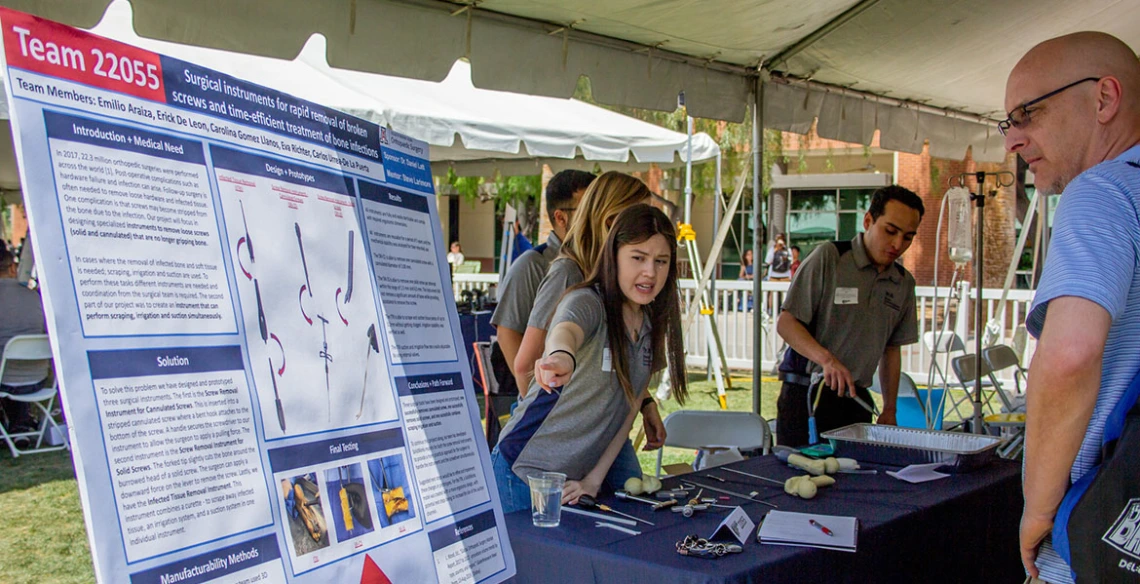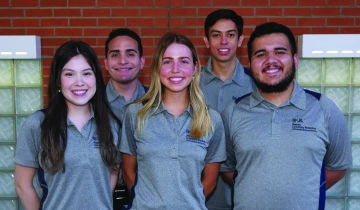UA Engineering Student-Designed Orthopedic Tools on Path to Market
The startup Ancerix plans to commercialize a toolkit of surgical instruments – which a team of seniors worked on for their capstone project – to remove bone rods and screws.

The students who began the project display their results at Craig M. Berge Design Day 2022.
A startup in the field of orthopedic surgery has emerged as a result of research and innovation at the University of Arizona, addressing specific challenges faced by surgeons in extracting hardware.
Dr. Daniel Latt, associate professor of biomedical engineering, who is also an associate professor in the College of Medicine – Tucson, led a multidisciplinary team of inventors that included five students who were completing an Interdisciplinary Capstone project as part of the Craig M. Berge Engineering Design Program.
Tech Launch Arizona, the university office that commercializes innovations stemming from research, worked with the team to file patents for its two inventions and license the intellectual property to a startup – Ancerix – formed to bring the inventions to the marketplace.
The technology forms the foundation for a set of medical instruments to tackle three common challenges in orthopedic hardware removal: screw heads that are inaccessible due to bone overgrowth; screws that spin freely and have lost purchase due to infection or poor bone quality; and pieces of a broken rod that are irretrievable because they lack attachment points.
In response to these challenges, Latt's team has engineered extraction devices that, upon approval by the Food and Drug Administration, will compose a comprehensive toolkit.
"I've always believed in addressing the real-world challenges we face in the operating room," Latt said. "These tools, stemming from our rigorous research at the University of Arizona, aim to offer practical solutions to specific issues we frequently encounter. It's about refining our approaches and ensuring we have the right tools at our disposal. Ancerix's toolkit, built upon our patented inventions, represents this very ethos."
A team of undergraduate engineering students led the initial design and testing of the tools as their capstone project. The team included Emilio Araiza, an aerospace and mechanical engineering major; Carlos Urea-De La Puerta and Erick De Leon, both former biomedical engineering majors; and former systems engineering majors Carolina Gomez Llanos and Eva Richter.

Back row from left: Emilio Araiza, Eric De Leon. Front row from left: Carolina Gomez Llanos, Eva Richter, Carlos Urea-De La Puerta.
Araiza is still pursuing his undergraduate degree. De La Puerta is pursuing a Ph.D. in biomedical engineering at Cornell University, Richter is an industrial engineer with W.L. Gore & Associates, Gomez Llanos is a systems engineer with Northrop Grumman and De Leon is a manufacturing associate at Moderna.
On the business side, Latt's collaborators in the startup include the veteran medical device designer Dr. Ramses Galáz and business development authority John Buttery. Galáz, with 15 years of experience, is an inventor on 34 granted patents spanning orthopedic surgery, intensive care and interventional cardiology. Buttery, known for his technological expertise and international acumen, brings a blend of entrepreneurial drive and vast experience in developing sales channels, further strengthening the team's prospects for business growth.
"Ancerix rests on collaboration, innovation and an unwavering commitment to superior patient care," said Buttery, president of Ancerix. "Our partnership with Dr. Latt and the licensed patents from the University of Arizona are a testament to this dedication. As we refine our orthopedic instruments with precision, we are firmly set on achieving the rigorous benchmarks for FDA approval. Subsequent to this, the Ancerix toolkit will be introduced to orthopedic surgical groups globally."
Ancerix is actively pursuing seed round capital, with a target close by fall 2023. The company is refining instrument prototypes, finalizing designs and putting the technologies through comprehensive testing. Their next major milestone is submitting an application for FDA approval. Upon approval, Ancerix anticipates launching its orthopedic surgical toolkit by fall 2024.
This article appears in full at: University of Arizona News

